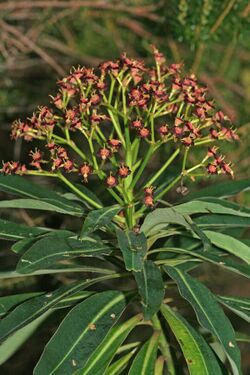Biology:Euphorbia mellifera
| Euphorbia mellifera | |
|---|---|

| |
| Scientific classification | |
| Kingdom: | Plantae |
| Clade: | Tracheophytes |
| Clade: | Angiosperms |
| Clade: | Eudicots |
| Clade: | Rosids |
| Order: | Malpighiales |
| Family: | Euphorbiaceae |
| Genus: | Euphorbia |
| Species: | E. mellifera
|
| Binomial name | |
| Euphorbia mellifera Aiton
| |
| Synonyms | |
| |
Euphorbia mellifera, the Canary spurge[2] or honey spurge,[3] is a species of flowering plant in the spurge family Euphorbiaceae, native to Madeira and the Canary Islands.[4][5] It is an evergreen shrub or tree growing to 2.5 m (8.2 ft) tall and broad,[6] with narrow leaves up to 20 cm (8 in) long. In spring it produces brown, honey-scented flowers.[7]
The Latin specific epithet mellifera means "producing honey".[8]
It has gained the Royal Horticultural Society's Award of Garden Merit.[6][9] Euphorbia × pasteurii is listed[10] as a hybrid between E. mellifera and E. stygiana. The cultivars 'Phrampton Phatty',[11] 'Roundway Titan'[12] and 'John Phillips'[13] have received the RHS AGM.
Like all euphorbias, this plant contains a milky-white sap, which oozes out of the stems when cut. This can be a skin irritant and is very harmful to the eyes. Gloves should be worn when pruning,
References
- ↑ Rivers, M.C.; Fernandes, F.; da Silva Menezes de Sequeira, M. (2017). The IUCN Red List of Threatened Species 2017 - Euphorbia mellifera. doi:10.2305/IUCN.UK.2017-3.RLTS.T102818634A102818638.en..
- ↑ (xls) BSBI List 2007, Botanical Society of Britain and Ireland, https://bsbi.org/download/3542/, retrieved 2014-10-17
- ↑ Euphorbia mellifera in BoDD – Botanical Dermatology Database
- ↑ "Flora de Canarias: Euphorbia_mellifera". http://www.floradecanarias.com/euphorbia_mellifera.html.
- ↑ Bramwell, D.; Bramwell, Z. (2001). Wild flowers of the Canary Islands. Madrid, Spain: Editorial Rueda. ISBN 978-84-7207-129-2.
- ↑ 6.0 6.1 "Euphorbia mellifera". Royal Horticultural Society. https://www.rhs.org.uk/Plants/7071/Euphorbia-mellifera/Details.
- ↑ RHS A-Z encyclopedia of garden plants. United Kingdom: Dorling Kindersley. 2008. pp. 1136. ISBN 978-1405332965.
- ↑ Harrison, Lorraine (2012). RHS Latin for gardeners. United Kingdom: Mitchell Beazley. pp. 224. ISBN 9781845337315.
- ↑ "AGM Plants - Ornamental". Royal Horticultural Society. July 2017. p. 38. https://www.rhs.org.uk/plants/pdfs/agm-lists/agm-ornamentals.pdf.
- ↑ "World Checklist of Selected Plant Families - Euphorbia × pasteurii". Kew Science. http://wcsp.science.kew.org/namedetail.do?name_id=244833.
- ↑ "RHS Plantfinder - Euphorbia × pasteurii 'Phrampton Phatty'". https://www.rhs.org.uk/Plants/299328/i-Euphorbia-i-×-i-pasteurii-i-Phrampton-Phatty/Details.
- ↑ "RHS Plantfinder - Euphorbia × pasteurii 'Roundway Titan'". https://www.rhs.org.uk/Plants/236572/i-Euphorbia-i-×-i-pasteurii-i-Roundway-Titan/Details.
- ↑ "RHS Plantfinder - Euphorbia × pasteurii 'John Phillips'". https://www.rhs.org.uk/Plants/227876/i-Euphorbia-i-×-i-pasteurii-i-John-Phillips/Details.
| Wikimedia Commons has media related to Euphorbia mellifera. |
Wikidata ☰ Q3303390 entry
 |


